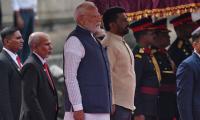Islamabad :Pakistan has an estimated 37,137 People Who Inject Drugs (PWIDs) spread over 7,401 spots in 14 cities; 64,829 Sex Workers (SWs) spread over 4,514 spots in 18 cities; and 31,790 Transgenders (TGs) spread over 9,820 spots in 23 cities, reveals a latest mapping study conducted to create evidence for the development of HIV prevention strategies.
The study, which will officially be launched today (Tuesday), also identified 8,606 geographical spots where an average number of 46,264 Men Having Sex With Men (MSM) congregate. Another 27,986 MSM were estimated using virtual mapping.
Titled ‘Mapping of key populations in Pakistan 2015-2016,’ the study’s objective is to update population size estimates of selected key populations i.e., People Who Inject Drugs (PWIDs), Female Sex Workers (FSWs), Men Having Sex with Men (MSM) and Transgenders (TGs). Of the 23 cities and towns selected for mapping, 13 were in Punjab, 6 in Sindh, and 2 cities each in Khyber-Pakhtunkhwa and Baluchistan.
The report is a joint effort of the National AIDS Control Programme and UNAIDS. The Centre for Global Public Health, University of Manitoba, Canada, and its local team in Pakistan, provided technical support for the study. Moreover, a Technical Working Group was set up to oversee the execution of the study.
The study mapped People Who Inject Drugs (PWIDs) in 14 cities, where an estimated 37,137 PWIDs were spread over 7,401 spots. Of the total PWIDs mapped, almost two-thirds were reported from Karachi, which has 24,036 PWIDs, making up 7.4% of the total estimated PWIDs, followed by Bahawalpur (2,755 PWIDs) and Hyderabad (2,164 PWIDs).
The predominant proportion of PWIDs was men; a very insignificant number of female PWIDs (44 from 19 spots) were also reported. The highest numbers of spots were street-based (public places and parks, on the street, in vacant grounds, under bridges, outside shops, near markets), where 81% of the PWIDs congregate, and because of the high price of drugs, pool their money to purchase drugs. Cemeteries or abandoned buildings were the second most frequented spot, reported by 9% of the PWIDs. Private residences/homes made only 4% of the spots for PWIDs.
The mapping of Female Sex Workers (FSWs) was conducted in 18 cities, where 64,829 SWs were spread over 4,514. FSWs form one the largest key populations, with Karachi having the highest number of FSWs (25,191), which made 39% of the total sex workers in the cities mapped. Karachi was followed by Sheikhupura (6,252) and Bahawalpur (6,201).
A number of operational typologies were defined based on the way sex workers operate and interact with their clients and peers. The main typologies reported were Kothikhana (KK) based (36%), followed by residence or home-based (29%), cell phone-based (17%) and street-based FSWs.
The average number of Transgenders (TGs) estimated in the 23 cities mapped were 31,790 at 9,820 spots. Four cities had the major concentration of TGs, forming more than 60% of the total estimated number of TGs in Pakistan. These cities are Karachi (9,123), Lahore, (3,936), Multan (3,130) and Faisalabad (2,737).
Of the total 9,820 spots identified through this mapping, 4,341 were spots at the streets/open spaces, which formed the largest typology of spots. An estimated 31,790 TGs operate through such spots. This was followed by 3,031 ‘deras’ mapped with 10,956 TGs. Approximately 6,625 TGs were mapped from 1,798 residential spots. Citywide analysis showed the largest spot sizes to be seen in Larkana (6.0), Quetta and Turbat (5.9) and Sargodha (5.7), while the smallest ones were reported for Multan (1.9), Bannu (2.2), Mirpur Khas (2.3) and Gujrat (2.4).
Although a large proportion of TGs are involved in sex work, not at TGs sell sex, the study highlights. A little more than 80% of all TGs in Pakistan were reported to sell sex, while in some of the cities mapped, almost all TGs are involved in sex work.
As far as Men Who have Sex with Men (MSM) are concerned, two parallel approaches were used to estimate their number: geographical and virtual mapping, the latter including identification of websites and mobile applications where MSMs connect with each other.
In all cities mapped, the study was able to identify 8,606 geographical spots where an average number of 46,264 MSMs congregate. Karachi reported the largest spot sizes and MSM estimates among the 23 cities mapped, with an average number of 18,361 MSM mapped at 3,495 spots.
The second largest MSM estimates were identified for Lahore (average of 5,471) followed by Multan (average of 4,265). The overall number of MSMs could be much more than what are estimated by this study, which can be due to reduced visibility owing to the overall stigma and discrimination experienced by this key population.
The largest proportion of MSMs operate through street spots, which form 63% of all geo-spots identified, followed by game clubs and net cafés, and hotels and guest houses. The majority of hotel and guesthouse MSM spots were reported from Karachi, Quetta, Sukkur and Multan. Results show that on usual days, the estimated number of MSMs is 27% lesser than numbers reported on peak days (weekends, salary days, festivals, etc.,)
The study draws a distinction between the term Male Sex Workers (MSWs) and MSMs. MSWs include males who provide sexual services i.e., anal or oral, to other males in return for money or other financial benefits. The numbers suggest that the predominant proportion of MSM that are present at geographical spots mapped were MSWs (85%). The cities with the least proportion of the MSM mapped who were MSW were Sialkot, Dera Ghazi Khan and Sheikhupura. On the other hand, more than 95% of the MSM mapped informed that they would sell anal sex for money to clients. Some of these cities included Bahawalpur, Hyderabad, Larkana, Multan, Nawabshah, Sukkhur, etc. In both mega cities i.e., Karachi and Lahore, three-fourth of the MSM mapped sell sex to clients.
In addition to geo-spot based MSMs, another 27,986 MSMs were estimated using virtual mapping. The highest number of MSMs who use Internet to look for other MSMs were estimated in Karachi (10,404), followed by Lahore (5,232) and Rawalpindi (4,258). A higher proportion of MSMs in larger cities used multiple MSM-related websites to seek for MSM partnerships. In smaller cites and towns, a smaller proportion of MSMs used multiple websites. On the other hand, MSMs in bigger cities reported having more than one identity on a single website. Among various Internet websites used, Facebook, Grinder and Pal Jam/Man Jam are the most utilized.
While efforts need to be focused on learning more about the HIV epidemic and its driving forces, scaling-up of the current National HIV/AIDS Response should be the key objective to contain HIV at its present level. The study very honestly admits that the “the HIV prevention programme in Pakistan is patchy and hasn’t sustained itself over the last five years.” The current capacity required for the fully scaled-up design and delivery of appropriate HIV prevention services is far from adequate, it adds. “Scaling-up will not only require an expansion in NGO and CBO capacity, but a more refined and focused effort to address the HIV prevention challenge,” the study concludes.







